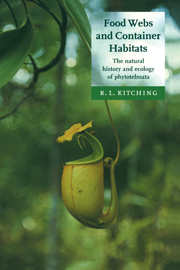Book contents
- Frontmatter
- Contents
- Preface
- 1 Introduction
- Part I The container flora, fauna and environment
- 2 The container flora
- 3 The container fauna
- 4 The phytotelm environment
- Part II Methods and theories
- Part III Patterns in phytotelm food webs
- Part IV Processes structuring food webs
- Part V Synthesis
- Annexe: The phytotelm bestiary
- References
- Index
2 - The container flora
The water-holding plants
Published online by Cambridge University Press: 26 August 2009
- Frontmatter
- Contents
- Preface
- 1 Introduction
- Part I The container flora, fauna and environment
- 2 The container flora
- 3 The container fauna
- 4 The phytotelm environment
- Part II Methods and theories
- Part III Patterns in phytotelm food webs
- Part IV Processes structuring food webs
- Part V Synthesis
- Annexe: The phytotelm bestiary
- References
- Index
Summary
Phytotelmata are formed whenever watertight hollows appear as part of the growth form of plants. They occur as five principal types with any number of additional minor categories. These five types – bromeliad ‘tanks’, pitcher plants, water-filled tree holes, bamboo internodes, and axil waters collected by leaves, bracts or petals – are all formed from parts of living plants. In a few instances water-collecting hollows are formed in the fallen parts of plants. For all these categories, in the vast majority of instances, the plants concerned are angiosperms. However, water-filled tree holes are recorded from a few ‘lower’ plants such as tree ferns and cycads, and Lounibos (1980) describes mosquito larvae from the rain-water pools collected in the concave tops of fungal basidiocarps.
In reviewing the plant groups from which an aquatic metazoan fauna has been recorded I draw heavily on the reviews of Thienemann (1934, 1954), Kitching (1971) and Fish (1983). Fish (1983) estimates that more than 1500 plant species may form phytotelmata. Given that water-filled tree holes may form, with greater or lesser frequency, in almost any species of tree, I suspect that this number is a significant underestimate.
I describe this special flora using the classification of phytotelmata alluded to above.
Bromeliad ‘tanks’
According to Frank (1983) the Bromeliaceae contain about 2000 species of plants divided into three subfamilies and about 50 genera. All but one of these species occur in the warm temperate to tropical regions of the Americas, from Florida to central Argentina and Chile.
Information
- Type
- Chapter
- Information
- Food Webs and Container HabitatsThe Natural History and Ecology of Phytotelmata, pp. 17 - 42Publisher: Cambridge University PressPrint publication year: 2000
Accessibility standard: Unknown
Why this information is here
This section outlines the accessibility features of this content - including support for screen readers, full keyboard navigation and high-contrast display options. This may not be relevant for you.Accessibility Information
- 1
- Cited by
